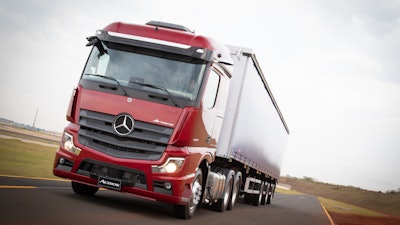
In December 2019, commercial vehicle registrations increased by 5.7% across the European Union, ending 3 months of decline.
Total new commercial vehicles
Demand was largely driven by the van segment, which accounted for over 86% of all CV registrations last month. Looking at the biggest markets, results were mixed. Both France (+7.4%) and the United Kingdom (+7.1%) posted growth in December, but registrations fell in Spain (-8.3%), Italy (-4.0%) and Germany (-1.7%).
Overall in 2019, EU demand for new commercial vehicles expanded by +2.5%, marking the seventh consecutive year of growth. Each of the major markets ended the year on a positive note: Germany (+6.1%), France (+4.3%), the United Kingdom (+3.0%), Italy (+1.9%) and Spain (+0.3%).
New light commercial vehicles (LCV) up to 3.5t
In December, registrations of light commercial vehicles went up 8.2%, reversing the downward trend of the preceding months. Three of the five key EU markets posted growth last month: France (+8.7%), the UK (+7.8%) and Germany (+1.6%). By contrast, demand contracted in Spain (-8.2%) and Italy (-3.1%). The exceptional performance of the Swedish van market (+180.3%) can be explained by an increase in the annual road tax announced for 2020.
Last year, new van registrations totalled 2.1 million units across the EU, a 2.8% increase compared to 2018. The introduction of WLTP for vans in September pulled forward registrations during the summer months, which subsequently slowed down from September to November. However, that effect eased in December, with demand for vans going up again. The five big markets all posted gains last year, with Germany (+6.9%) and France (+4.5%) making a particularly important contribution.
New heavy commercial vehicles (HCV) of 16t and over
December 2019 results of the heavy-duty segment were 13.6% lower than the same month in 2018, making it the sixth consecutive month of falling demand in 2019. The main reason for this downturn is the introduction of new, obligatory tachographs in heavy trucks from 15 June 2019. As a result, the major EU markets performed worse than the year before. Germany (-20.4%), the United Kingdom (-15.4%) and France (-11.9%) posted double-digit declines in the last month of the year.
In 2019, heavy-truck registrations across the EU remained more or less stable compared to 2018 due to the growth recorded in the first half of 2019. With the exception of Italy (-7.7%), all key markets posted gains last year: the UK (+9.2%), Spain (+2.8%), France (+2.1%) and Germany (+1.9%).
New medium and heavy commercial vehicles (MHCV) over 3.5t
In December, EU demand for new trucks decreased (-9.4%) for the sixth month in a row. This was mainly the result of the decline in heavy-truck registrations, which made up the bulk of total truck demand. The region’s main markets followed this negative trend, with Germany (-12.2%), Italy (-11.7%) and France (-10.5%) seeing double-digit drops.
2019 ended positively for the EU truck market (+0.9%), despite the slowdown observed in the second half of the year. The United Kingdom (+9.5%), Germany (+4.2%), France (+1.5%) and Spain (+1.1%) all performed better than in 2018. Italy (-7.6%) was the only key market with falling demand.
New medium and heavy buses & coaches (MHBC) over 3.5t
Last month, EU demand for buses and coaches recorded a modest increase (+1.2%), ending the negative trend that started in July. However, the five big markets still posted diverse results in December. France and the UK saw exceptional growth in the last month of the year (+69.6% and +41.8% respectively), while sales declined sharply in Spain (-31.8%) and Germany (-15.7%).
In 2019, new bus and coach registrations expanded by +1.8% across the European Union, despite the negative performance of the segment during the second half of the year. It is worth noting that the Central European countries gave a strong boost (+5.1%) to the full-year total. Among the major Western European markets, only France (+8.8%) made a positive contribution to the region’s growth.


















